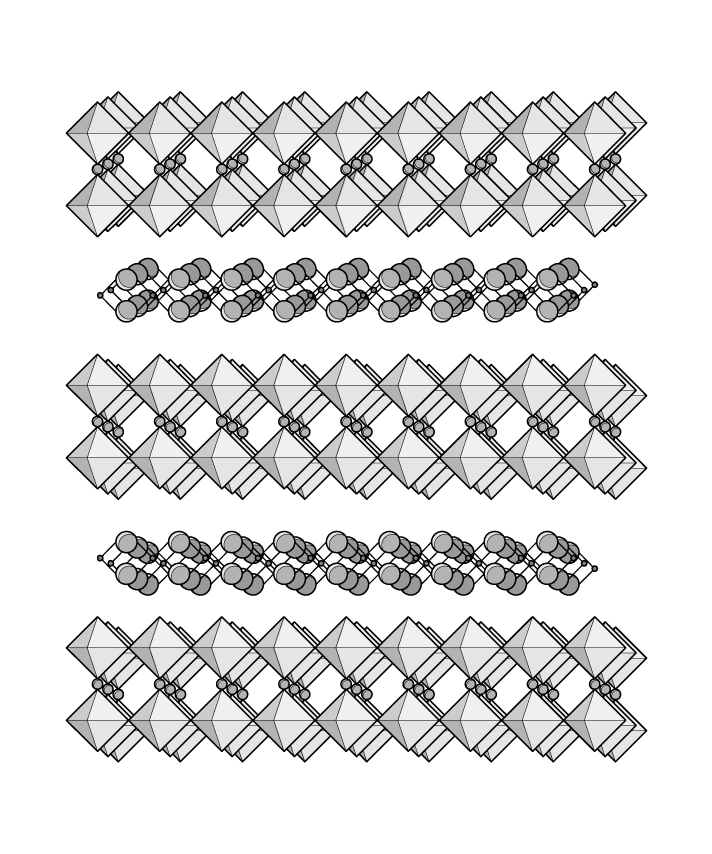Perovskites may be structured in layers, with the base ABO3 structure separated by thin sheets of intrusive materials. Ruddlesden-Popper (RP) phase has general formula An-1A’2BnX3n+1, where A and A’ represent alkali, alkaline earth, or rare earth metal, while B refers to transition metal. Aurivillius phase consist of n perovskite-like layers (An-1BnO3n+1)2- sandwiched between bismuth-oxygen sheets (Bi2O2)2+.
 chart.png)

Pictorial view of Ruddlesden-Popper phases (Left). Aurivillius phase, Bi2SrTa2O9, (Right)
Classification
Perovskite materials exhibit many interesting and intriguing properties from both the theoretical and the application point of view. Based on the properties we shall tentatively group perovskites into the following three groups:
- Superconducting perovskites
- Colossal magnetoresistance perovskites
- Piezoelectric & ferroelectric perovskites
Applications
In the broad sense, the perovskites are often called, "Functional Materials", due to the interplay of structural, magnetic and transport properties. Superconductivity, colossal magnetoresistance, and ferroelectricity are discussed in Sects II, III, and IV, respectively. Here we shall list most common applications for other perovskites:
- Thermopower generation;
- Ion conductors in fuel cells/sensors;
- Catalytic materials (for instance, Co-based perovskite material is as a replacement for Pt in catalytic converters in diesel vehicles);
- Photovoltanics. Synthetic perovskites have been identified as possible inexpensive base materials for high-efficiency commercial photovoltaics.
Superconducting Perovskites
Ordinary metallic superconductors (Hg,Nb,Nb3Sn) usually have a transition temperatures (temperatures below which they superconduct) below 30 K (−243.2 °C). In 1986 a high temperature (high TC) superconductivity was discovered in Cu-based ceramic materials.
LTS offers the following superconducting ceramics:
- Thallium barium calcium copper oxide (TlBa2Can-1CunO2n+3)
- Bismuth strontium calcium copper oxide (Bi2Sr2Can−1CunO4+2n+x, where n = 1, 2 and 3)
- Yttrium barium copper oxide (YBa2Cu3O7-y, where 0.4<y<0.9)
- (Re1-xAxCuO4, where R = La, Nd, Pr, A = Ba, Sr)
- (MgCNi3)
- (Ba1-xKxBiO3+δ)
COLOSSAL MAGNETORESISTANCE PEROVSKITES
More than 40 years after their discovery the La1-xCaxMnO3 perovskites have attracted renewed interest, especially due to their interesting electronic, magnetic, and structural properties as well as for their potential technological applications. The term "colossal magnetoresistance" (CMR) was introduced recently to describe the large temperature and magnetic field dependences of the resistivity in La1-xAxMnO3-δ (A=Ca,Sr,Ba) perovskites.
LTS offers the following CMR ceramics:
- Lanthanum calcium manganese oxide or in general, (Re1−xCaxMnO3+δ with Re=Y, La, Ce, Pr, etc. and 0 ≤ x ≤ 1, -0.1 ≤ δ ≤ 0.1)
- Lanthanum strontium manganese oxide (La1-xSrxMnO3+δ with 0 ≤ x ≤ 1)
- Lanthanum barium manganese oxide (La1−xBaxMnO3+δ, with 0 ≤ x ≤ 1)
PIEZOELECTRIC & FERROELECTRIC PEROVSKITES
Of the thirty-two crystal classes twenty exhibit piezoelectricity (single crystal which don’t have a center of symmetry). Ten of these represent the polar crystal classes, which show a spontaneous polarization without mechanical stress due to a non-vanishing electric dipole moment associated with their unit cell. Those are pyroelectric. If the dipole moment can be reversed by the application of an electric field, the material is said to be ferroelectric (FE).
Ceramic powders with randomly oriented grains must be ferroelectric to exhibit piezoelectricity.
Applications:
- High voltage and power sources (piezo-based ignition systems, piezoelectric transformer)
- Sensors (microphones, sonars, strain/tilt sensing, microbalances)
- Actuators (piezoelectric motors, acousto-optic modulators, focused ultrasound delivery)
- Vibration dampers
- Frequency standards (quartz clocks, frequency multipliers)
- Hybrid cells (photovoltaic - piezoelectric, CMRs and HTSCs junctions with FE barrier)
LTS offers the following piezoceramics:
- Barium titanate (BaTiO3)
- Lead zirconate titanate (PbZrxTi1−xO3, 0 ≤ x ≤ 1)
- Potassium niobate (KNbO3)
- Lithium niobate (LiNbO3)
- Bismuth titanate (Bi4Ti3O12)
- Bismuth ferrite (BiFeO3)
Chemicals for the new frontier
